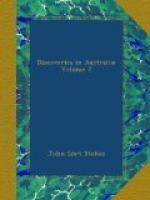OBSERVATIONS ON THE CLIMATE AND WINDS IN THE GULF.
During our visit to this part of the continent we found the climate well suited for Europeans; but what it might be in the middle of the north-west monsoon we had no opportunity of ascertaining. At its commencement in the month of November, Flinders found the thermometer to range on board between 81 and 90 degrees; but on shore, he says, that in the course of the day it might have been about seven degrees higher; the temperature, however, being alleviated by constant breezes either from sea or land, it was seldom oppressive. In July, as I have already stated, the thermometer, on one occasion, at 5 A.M., was down to 51 degrees; and on another, at noon, up to 87 degrees, being, in the first instance, six degrees lower than it was on board, and in the second, seven degrees higher, which gave an excess in the shore range of thirteen degrees. Generally on the land it was below 62 degrees before 7 A.M. and after 6 P.M. The range of the barometer in November was from 29.70 to 30.06; whilst with us, in July, its maximum height was 30.08, and minimum 30.02; the lowest being in both seasons with winds from the land, coinciding with what had been observed on other parts of the continent, that winds from the sea raise the mercury, and those from the land depress it.
The winds in July were fresh from South to South-East for about two days before and after the change in the moon. They began at midnight, increasing to almost a strong breeze between five and six in the morning, and dying away again towards noon, when a calm of five hours duration succeeded; at other times light land and seabreezes prevailed.
It will appear from this description of the winds in the Gulf of Carpentaria that they bear a great similarity to those experienced at the same season on the North-West coast, near Depuch Island; and the circumstance of the temperature being lowest when they were strongest from the land is also the same. This was there supposed to have been occasioned by the great radiation of heat from the land over which they blew; but as the country at the head of the Gulf of Carpentaria is not of a cold clayey nature, the idea is naturally suggested that there must be a great extent of swampy ground in the interior, which strengthens the opinion I have before expressed.
SUPPOSED ISLANDS.
After hoisting in the boats we shaped a course along the eastern shore of the Gulf towards Booby Island. Our being obliged to return thither, for a chronometric departure prevented our examining the middle of the upper part of the Gulf, where, according to certain vague reports, there exist islands. It is stated, for example, that after the south-west monsoon has set in strongly, numbers of coconuts are thrown on the north-west shore of the Gulf of Carpentaria. In the year 1839, moreover, a small proa was driven off the coast of Timor Laut during the north-west monsoon.




